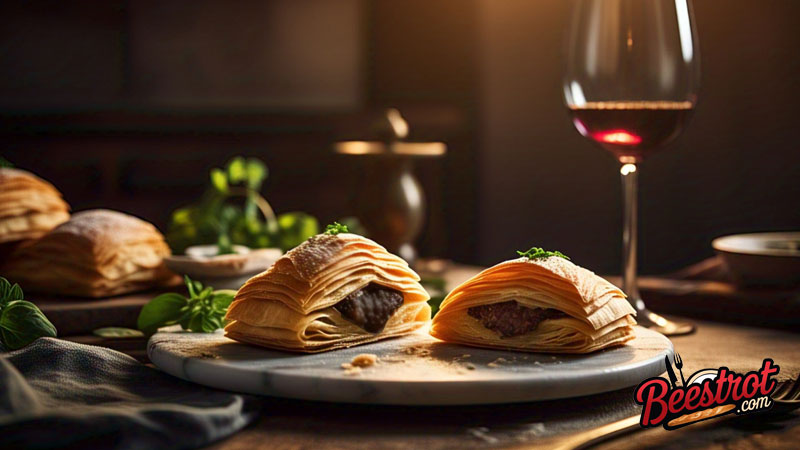Sfogliatelle

Click here to learn about our image policy and how to submit your own!
Sfogliatelle, meaning "many leaves" in Italian, originated in a Neapolitan convent during the 17th century. These intricate shell-shaped pastries feature dozens of paper-thin layers of pastry dough that create a distinctively crisp, flaky texture. The ridged exterior cradles a sweet semolina and ricotta filling infused with candied citrus and cinnamon, resulting in a harmony of textures and flavors that has made this labor-intensive pastry one of southern Italy's most treasured culinary achievements.
Time & Quantities
Method & Ingredients
Required Equipment: Stand mixer with dough hook, pasta roller or rolling pin, saucepan, pastry brush, baking sheets, parchment paper, sharp knife
Cooking Method: Baking
Ingredients
- For dough: 4 cups all-purpose flour
- 1 tsp salt
- 1 1/4 cups warm water
- 4 oz lard or butter 0::. For filling: 2 cups whole milk
- 1/2 cup semolina flour
- 1 cup ricotta cheese
- 3/4 cup granulated sugar
- 2 large eggs
- 1 tsp cinnamon
- 1 tsp vanilla extract
- 1/4 cup candied orange peel
- 1/4 cup candied citron
- zest of 1 lemon
- confectioners' sugar for dusting
Instructions
- For dough: In stand mixer with dough hook, combine flour and salt. Gradually add warm water, mixing until a smooth dough forms.
- Knead dough for 10 minutes until elastic and smooth. Cover with plastic wrap and rest for 30 minutes.
- Divide dough into 2 pieces. Roll first piece through pasta roller gradually decreasing thickness settings until very thin (almost translucent) - this is where the magic begins!
- Brush entire surface with melted lard or butter.
- Roll second piece of dough equally thin and place on top of first. Brush with more fat.
- Starting from the narrow end, roll dough into a tight log - think Swiss roll but much tighter!
- Wrap log in plastic and refrigerate overnight (patience yields perfection!).
- For filling: In saucepan, bring milk to simmer. Slowly whisk in semolina, stirring constantly until thick (about 2-3 minutes).
- Remove from heat, spread onto baking sheet to cool completely.
- In bowl, combine cooled semolina, ricotta, sugar, eggs, cinnamon, vanilla, candied peels, and lemon zest. Mix until smooth.
- Refrigerate filling for at least 1 hour.
- Preheat oven to 400°F (200°C). Line baking sheets with parchment paper.
- Remove dough log from refrigerator, cut into 1/2-inch slices.
- Hold each slice in palm of hand, use thumb to create a cone shape by gently pressing center - be careful not to tear those beautiful layers!
- Fill each cone with about 2 tablespoons of filling. Pinch edges to seal.
- Place on prepared baking sheets and bake for 25-30 minutes until golden brown and crisp.
- Cool slightly, dust with confectioners' sugar, and serve warm for maximum 'wow' factor.
Storage & Make-Ahead
Storage Advice: Best enjoyed fresh. Can be stored at room temperature for 1 day or refrigerated for up to 3 days. Reheat in 325°F (165°C) oven for 5-10 minutes to re-crisp before serving.
Make-Ahead & Freezing Tips: The dough can be prepared and rolled 2-3 days ahead and kept refrigerated. The filling can be made 1 day ahead. Assembled pastries can be frozen unbaked and baked directly from frozen.
Nutritional & Dietary Information
Nutritional Information:
- Calories: 360
- Protein: 8g
- Fat: 14g (Saturated: 8g)
- Carbohydrates: 50g (Fiber: 1g, Sugar: 24g)
- Vitamin A: 8% DV
- Vitamin C: 2% DV
- Calcium: 10% DV
- Iron: 15% DV
Allergen Information: Contains dairy (milk, ricotta, butter/lard), eggs, wheat (flour)
Dietary Information: Contains dairy, eggs, and gluten; not suitable for vegans, vegetarians, or those with dairy, egg, and gluten allergies
Serving & Variations
Serving Suggestions: Serve warm on a decorative platter with a light dusting of confectioners' sugar. These impressive pastries are perfect for special occasions or as the highlight of an Italian dessert table.
Wine or Drink Pairing: A sweet Moscato d'Asti or Vin Santo complements the delicate citrus flavors. For a non-alcoholic pairing try a citrus-infused tea or espresso.
Possible Recipe Variations: Lobster Tail Variation: Instead of shaping into cones, form into tail shapes. Chocolate Variation: Add 2 tablespoons cocoa powder and mini chocolate chips to filling. Modern Version: Add a touch of limoncello to the filling for extra citrus punch.
Additional Notes: This is an advanced recipe requiring patience and precision. The layers should be as thin as possible for authentic texture. Traditional sfogliatelle are shaped like seashells with visible ridges.







These look yummy. Saving for a baking weekend! Thanks.
These Italian pastries were incredible! I had them once in Naples and have dreamed about them since. The laminated dough was challenging but your instructions made it easier. Will do it again. Thank you Beestrot!